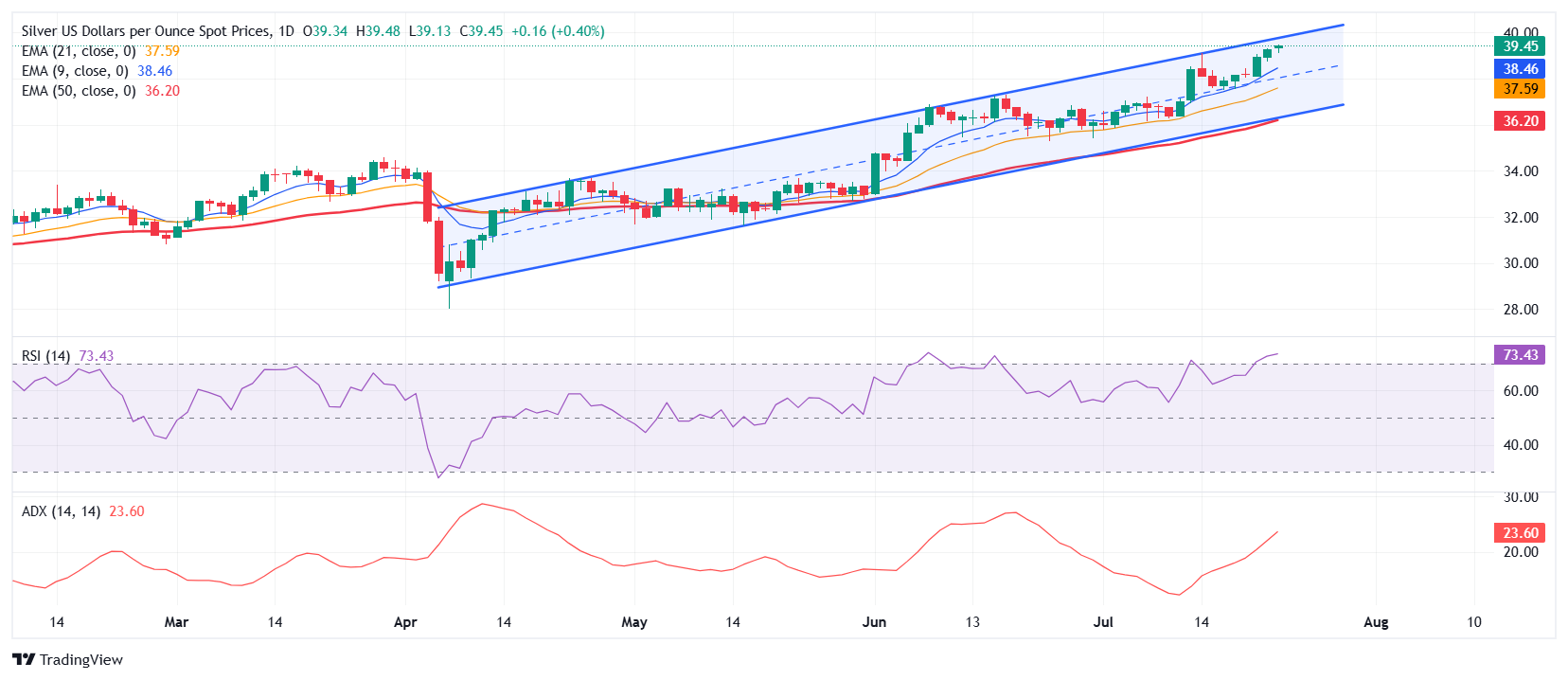Silver Price Forecast: XAG/USD treads water near multi-year highs amid cautious optimism
- Silver (XAG/USD) is consolidating below $39.50 after a sharp three-day rally, up 3.33% so far this week.
- The metal printed a fresh 14-year high of $39.48, trading at levels last seen in September 2011.
- The RSI is hovering near 73, reflecting strong bullish momentum, though overbought conditions could limit further upside in the near term.

Silver (XAG/USD) is treading water on Wednesday after a sharp two-day run to mark fresh multi-year highs. The metal consolidating just below the key $39.50 mark during the American trading hours. While bullish momentum remains intact, the pause comes as the US Dollar (USD) stabilizes on the back of a trade agreement between the United States and Japan, which has injected a dose of cautious optimism into broader markets and tilted sentiment toward risk-on.
Despite the intraday slowdown, Silver still trades near 14-year highs, at levels last seen in September 2011, underlining the strength of the ongoing uptrend. The metal is up nearly 3.33% so far this week and continues to ride the wave of broad-based Greenback weakness.
On the daily chart, Silver is edging higher along the upper boundary of a well-defined rising channel that has contained price action since early April. Price is holding well above the short-term Exponential Moving Averages (EMAs) — 9, 21, and 50-day — all of which are sloping upward and reinforcing the underlying bullish momentum.
The Relative Strength Index (RSI) oscillates around 73, firmly in overbought territory, yet there's no clear sign of a reversal or bearish divergence—an encouraging signal for bulls that the momentum remains strong. Still, with the rally looking a bit stretched, traders may start to tread cautiously, watching for signs of exhaustion. Meanwhile, the Average Directional Index (ADX) is also nudging higher, now around 23.60, suggesting that the underlying trend is not only intact but gradually gaining strength.
With the broader technical structure favoring the bulls, the immediate upside target lies at the psychological $40.00 mark, a level that could act as both a magnet and a short-term hurdle. A clean breakout above this area would likely trigger fresh buying interest, opening the door toward $42.00, and possibly $43.00 in the near term, especially if macro drivers like soft Treasury yields and a weaker Greenback continue to support the metal.
On the downside, initial support is seen near the $38.45-$38.10 zone, which lines up with the mid-channel trendline and the 9-day EMA. A deeper pullback could test the 21-day EMA around $37.59, while the 50-day EMA at $36.20 near the lower boundary of the rising channel offers more solid support and keeps the broader trend firmly intact.
Silver FAQs
Silver is a precious metal highly traded among investors. It has been historically used as a store of value and a medium of exchange. Although less popular than Gold, traders may turn to Silver to diversify their investment portfolio, for its intrinsic value or as a potential hedge during high-inflation periods. Investors can buy physical Silver, in coins or in bars, or trade it through vehicles such as Exchange Traded Funds, which track its price on international markets.
Silver prices can move due to a wide range of factors. Geopolitical instability or fears of a deep recession can make Silver price escalate due to its safe-haven status, although to a lesser extent than Gold's. As a yieldless asset, Silver tends to rise with lower interest rates. Its moves also depend on how the US Dollar (USD) behaves as the asset is priced in dollars (XAG/USD). A strong Dollar tends to keep the price of Silver at bay, whereas a weaker Dollar is likely to propel prices up. Other factors such as investment demand, mining supply – Silver is much more abundant than Gold – and recycling rates can also affect prices.
Silver is widely used in industry, particularly in sectors such as electronics or solar energy, as it has one of the highest electric conductivity of all metals – more than Copper and Gold. A surge in demand can increase prices, while a decline tends to lower them. Dynamics in the US, Chinese and Indian economies can also contribute to price swings: for the US and particularly China, their big industrial sectors use Silver in various processes; in India, consumers’ demand for the precious metal for jewellery also plays a key role in setting prices.
Silver prices tend to follow Gold's moves. When Gold prices rise, Silver typically follows suit, as their status as safe-haven assets is similar. The Gold/Silver ratio, which shows the number of ounces of Silver needed to equal the value of one ounce of Gold, may help to determine the relative valuation between both metals. Some investors may consider a high ratio as an indicator that Silver is undervalued, or Gold is overvalued. On the contrary, a low ratio might suggest that Gold is undervalued relative to Silver.

